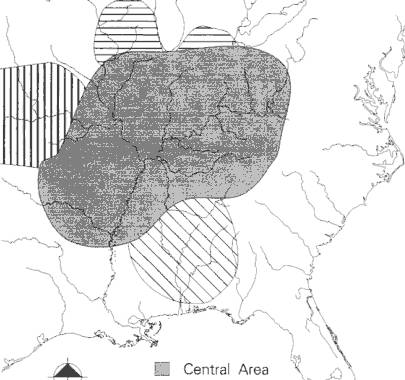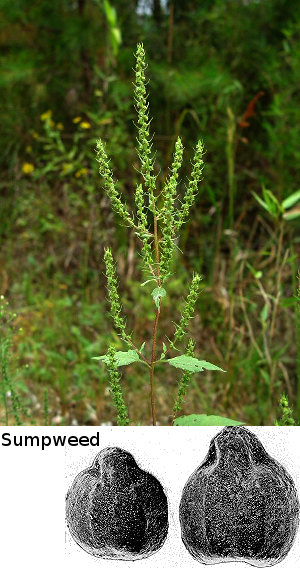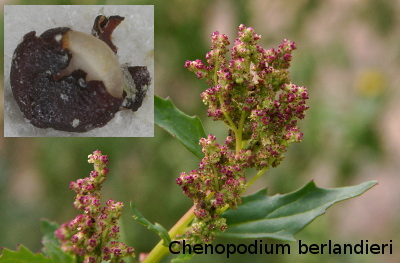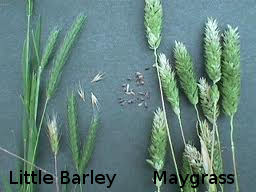
Eastern agricultural complex
 Most
laypeople believe that eastern native Americans didn't start farming
until corn, beans, and squash made their way north from Mexico,
becoming common crops around 1000 AD. But well before then,
Native Americans in the area shaded on this map had domesticated a
whole suite of other crops. These plants, known as the Eastern
Agricultural Complex, may have made up as much as 67% of the diet of
the Native Americans 2500 years ago, with the history of the plants'
cultivation extending perhaps as far back as 2050 BC.
Most
laypeople believe that eastern native Americans didn't start farming
until corn, beans, and squash made their way north from Mexico,
becoming common crops around 1000 AD. But well before then,
Native Americans in the area shaded on this map had domesticated a
whole suite of other crops. These plants, known as the Eastern
Agricultural Complex, may have made up as much as 67% of the diet of
the Native Americans 2500 years ago, with the history of the plants'
cultivation extending perhaps as far back as 2050 BC.
 Oily
seeds were an important part of the Eastern Agricultural
Complex. We're still familiar with one of these eastern North
American natives --- sunflowers. Another oil-seed crop is
familiar for a different reason --- the original squashes cultivated
in eastern North America had an inedible flesh and were instead grown
for their tasty seeds. Finally, sumpweed (also known as
marsh-elder) was an important crop which produced nutritional seeds
made up of 32% protein and 45% oil, but which has largely disappeared
from our knowledge-base. Gayle
Fritz's Laboratory Guide to
Archaeological Plant Remains from Eastern North America notes that "Harvesting
experiments using wild stands show that sumpweed holds considerable
economic potential."
Oily
seeds were an important part of the Eastern Agricultural
Complex. We're still familiar with one of these eastern North
American natives --- sunflowers. Another oil-seed crop is
familiar for a different reason --- the original squashes cultivated
in eastern North America had an inedible flesh and were instead grown
for their tasty seeds. Finally, sumpweed (also known as
marsh-elder) was an important crop which produced nutritional seeds
made up of 32% protein and 45% oil, but which has largely disappeared
from our knowledge-base. Gayle
Fritz's Laboratory Guide to
Archaeological Plant Remains from Eastern North America notes that "Harvesting
experiments using wild stands show that sumpweed holds considerable
economic potential."
Small "grains" (meaning
plants with starchy seeds in this context) were
also important, and are mostly familiar to us now as garden
weeds. Look for lamb's quarter, maygrass, erect knotweed, and
little barley in your garden and think of their long history.
In the case of most of
the species in the Eastern Agricultural Complex,
Native Americans selected for plants that were easier to harvest or
better to eat, so we can distinguish the wild ancestors from the
domesticated versions in the archaeological  record.
As a result,
you shouldn't assume that the lamb's quarter you pull out of your
garden every year is the same as the one the Native Americans
grew. First of all, the most common lamb's quarter weed is in a
different species (Chenopodium
album instead of
Chenopodium
berlandieri).
Even if you tracked down a wild Chenopodium
berlandieri,
it probably wouldn't look much like the domesticated version since the
Native Americans bred their lamb's quarter to produce all of its
flowers at the same time and to concentrate the enlarged seeds in the
top inflorescence for easy harvest. In fact, like most of our
current garden vegetables, the varieties in the Eastern Agricultural
Complex had changed so much from the wild type that they depended on
humans to propagate
them and many couldn't reproduce or compete naturally in the wild.
record.
As a result,
you shouldn't assume that the lamb's quarter you pull out of your
garden every year is the same as the one the Native Americans
grew. First of all, the most common lamb's quarter weed is in a
different species (Chenopodium
album instead of
Chenopodium
berlandieri).
Even if you tracked down a wild Chenopodium
berlandieri,
it probably wouldn't look much like the domesticated version since the
Native Americans bred their lamb's quarter to produce all of its
flowers at the same time and to concentrate the enlarged seeds in the
top inflorescence for easy harvest. In fact, like most of our
current garden vegetables, the varieties in the Eastern Agricultural
Complex had changed so much from the wild type that they depended on
humans to propagate
them and many couldn't reproduce or compete naturally in the wild.
 Are you interested in trying
to grow some of North America's most ancient
crops in your own garden. Too bad! Just as modern farmers
are ignoring the hundreds of varieties of heirloom vegetables
well-suited to their climate in favor of a few industrial varieties,
Native American farmers quickly ditched most components of the Eastern
Agricultural Complex when corn came on the scene. By the time of
European contact, all domesticated varieties except sunflowers and
squash were extinct.
Are you interested in trying
to grow some of North America's most ancient
crops in your own garden. Too bad! Just as modern farmers
are ignoring the hundreds of varieties of heirloom vegetables
well-suited to their climate in favor of a few industrial varieties,
Native American farmers quickly ditched most components of the Eastern
Agricultural Complex when corn came on the scene. By the time of
European contact, all domesticated varieties except sunflowers and
squash were extinct.
| This post is part of our Native American Paleoethnobotany lunchtime
series.
Read all of the entries: |
Want more in-depth information? Browse through our books.
Or explore more posts by date or by subject.
About us: Anna Hess and Mark Hamilton spent over a decade living self-sufficiently in the mountains of Virginia before moving north to start over from scratch in the foothills of Ohio. They've experimented with permaculture, no-till gardening, trailersteading, home-based microbusinesses and much more, writing about their adventures in both blogs and books.
Want to be notified when new comments are posted on this page? Click on the RSS button after you add a comment to subscribe to the comment feed, or simply check the box beside "email replies to me" while writing your comment.
- Remove comment
- Remove comment
